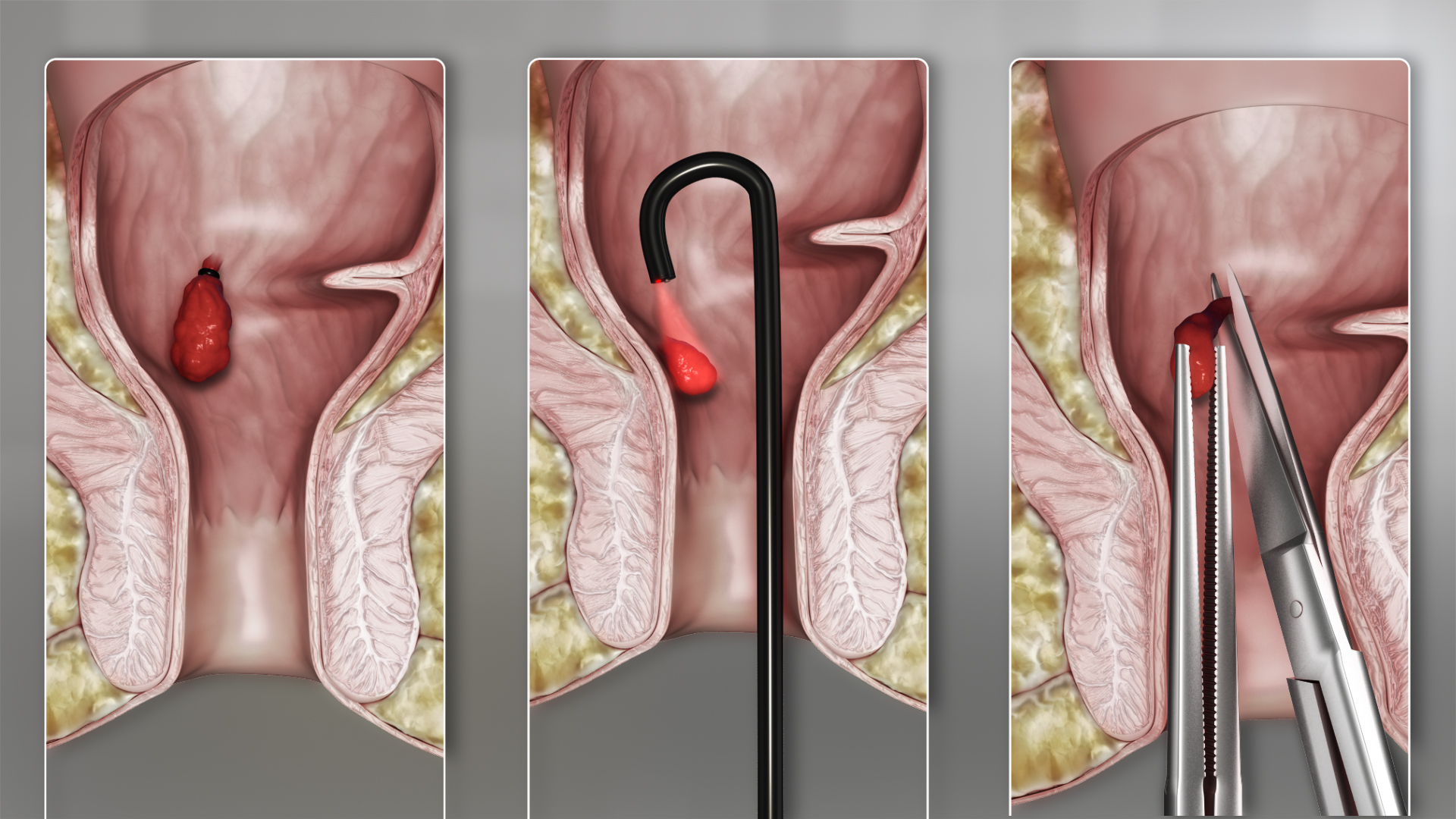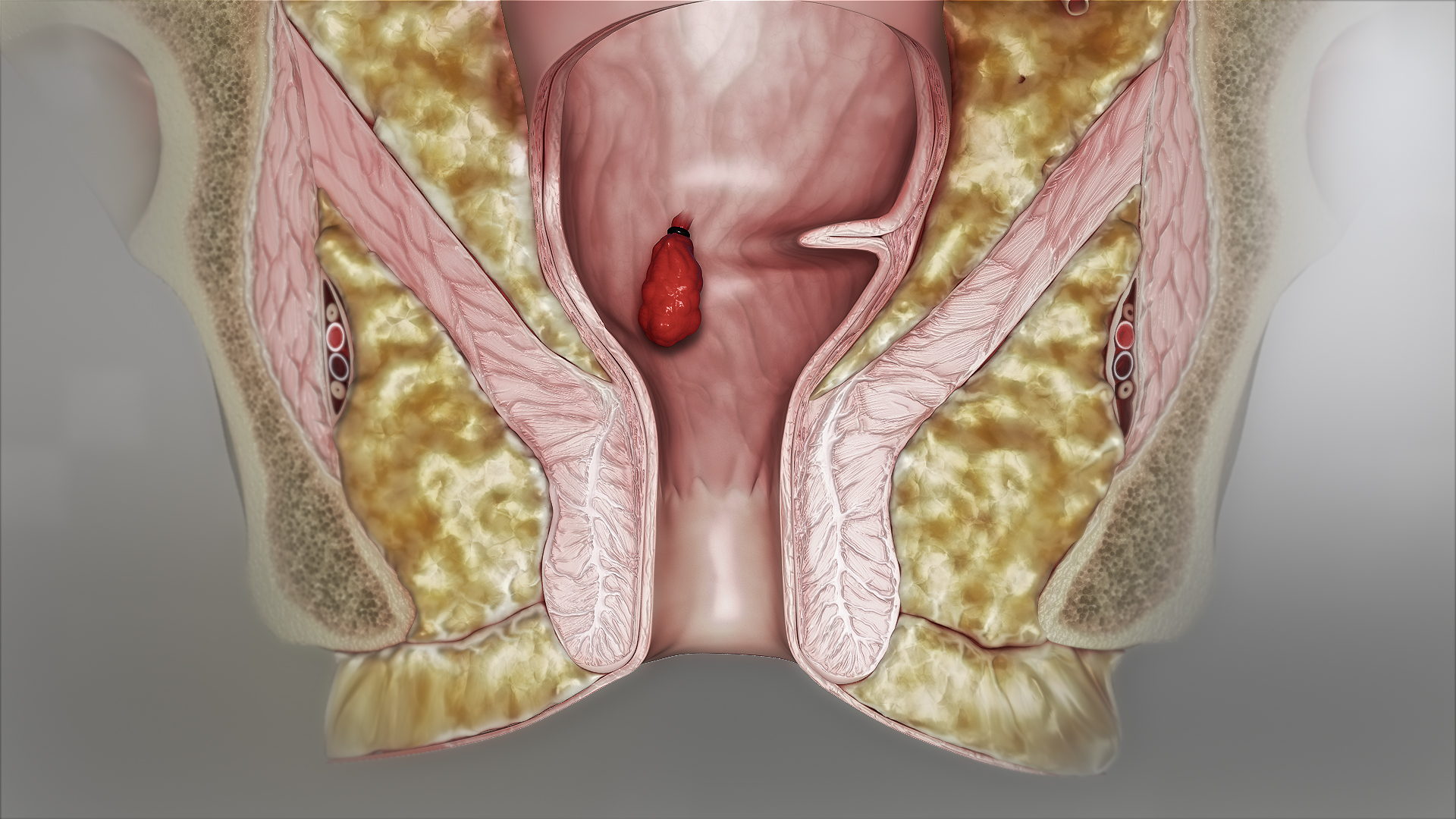Hemorrhoids, also known as piles, is a condition when the anal or lower rectal veins get swollen. It results in painless bleeding during bowel movements, irritation in the anal region, and often even pain in or around the anus. The symptoms vary, depending on where the hemorrhoids are located.

3D medical animation stills for Internal Hemorrhoids Treatment
Internal hemorrhoids occur inside the rectum and rarely cause discomfort. However, straining pressure while passing stool can lead to bleeding.
External hemorrhoids are present under the anal skin. They often feel itchy and painful. Sometimes blood may pool in an external hemorrhoid and form a painful clot that appears as a swollen lump around the anus. These are called thrombosed hemorrhoids.
Causes
The veins around your anus tend to stretch under pressure and may bulge or swell as a consequence of being overweight, pregnant, or simply straining during bowel movements (due to diarrhea or constipation). Sometimes anal intercourse may also be a cause for hemorrhoids. By 50 years, hemorrhoids often become an ongoing complaint as the support tissues around the rectal veins get weak with increasing age.
Treatment
1. Easy home remedies
Consuming fibrous foods, such as fruits, vegetables and whole grains helps in easy passage of stool and prevents gas.
Topical treatments available over-the-counter like hemorrhoid ointment or suppository containing hydrocortisone, or use pads containing witch hazel or a numbing agent, are also helpful. Oral pain relievers may also be used to relieve discomfort.
Soaking the anal area in warm bath for 10 to 15 minutes two to three times a day can also be an effective way of treating hemorrhoids.
It is important to maintain hygiene of the anal area, but avoid alcohol-based or perfumed wipes. Ensure that the area is pat dried or air-dried.
Cold compression also helps to relieve anal swelling.
2. Minimally invasive procedures
- Thrombectomy
External hemorrhoid can be effectively removed within 3 days of development through a simple incision that will allow the draining of blood and may provide instant relief.
- Rubber band ligation
The procedure involves placing a couple of small rubber bands around the base of an internal hemorrhoid. This cuts off the blood supply to the hemorrhoid, ensuring that it falls off within a week.
- Sclerotherapy
In this procedure, a chemical solution is injected into the hemorrhoid tissue to shrink it. The technique may be less effective than rubber band ligation. Read more about sclerotherapy here.
- Coagulation through radiations
Infrared, laser or bipolar rays are used to harden and shrivel internal hemorrhoids. While coagulation has few side effects and may cause little immediate discomfort, it's associated with a higher rate of recurrence compared to the rubber band treatment.

A still from a 3D Medical Animation about Rubber band ligation
3. Surgical procedures
Hemorrhoidectomy is the most effective and complete way to treat severe or recurring hemorrhoids. Complications may include temporary difficulty emptying the bladder and resulting urinary tract infections. Pain after the procedure can be relieved using medications or warm water baths.
Hemorrhoid stapling is done to block the circulation to hemorrhoidal tissue. It is typically used only for internal hemorrhoids. Stapling generally involves less pain than hemorrhoidectomy and allows for earlier return to regular activities. However, it is associated with a greater risk of recurrence and rectal prolapse. Complications can also include bleeding, urinary retention and pain, and rarely, even sepsis.
Conclusion
Hemorrhoids are a common but complex disease, affecting millions of Americans. It is important to distinguish this disease from other anorectal diseases and the symptoms should be carefully evaluated to exclude other masquerading entities. There are a multitude of options for the management of hemorrhoid disease and specific treatment choice should be based on individual patient and clinical factors.
Disclaimer: The information in no way constitutes, or should be construed as medical advice. Nor is the above article an endorsement of any research findings discussed in the article an endorsement for any of the source publications.








